In the Archives: 10 Least Persuasive Ads
Editor’s note: For this installment of Laura Bien’s bi-weekly local history column she counts down a top 10 list of least persuasive advertisements in old time Ypsilanti newspapers.
10. One early cereal offered a transformative experience.
Jim Dumps was a most unfriendly man,
who lived his life on the hermit plan;
In his gloomy way he’d gone through life,
And made the most of woe and strife;
Till Force one day was served to him-
Since then they’ve called him “Sunny Jim.”
Force breakfast wheat flakes were advertised in a 1902 Ypsilanti newspaper with one of the first brand mascots, Sunny Jim. It was only seven years earlier that John Harvey Kellogg had patented his “Flaked Cereals and Process for Preparing Same.” The popular Force ad campaign used six-line verses written by Minnie Maud Hanff and illustrated by Dorothy Ficken.
Jim Dumps asserted, “Too much meat
In summer causes too much heat.
What shall we eat all summer long,
That, without meat, shall keep us strong,
And in the best of summer trim?”
“Why, ‘Force,’ of course,” laughed ‘Sunny Jim.’
Though the poems now seem quaint, in his time Sunny Jim was a popular cultural icon for the cereal that promised “the strength of meat, without the heat.”
9. In an ad for another foodstuff, this 1885 Ypsilanti Commercial Royal Baking Powder chart makes plain the superior worth of Royal’s powder, which used cream of tartar as a leavening agent.
The ad’s backstory, however, is that many of Royal’s rival baking powder companies used cheaper and more plentiful alum instead. Royal’s William Ziegler aggressively instigated what would later be called the “alum war,” in which the company tried to discredit alum-based powders.
Royal went so far as to quietly introduce legislation, first in Missouri and then about 17 other states, that prohibited the use of “calomel, bismuth, ammonia, or alum” in the preparation of foods. Ostensibly a pure foods bill, the legislation was a stealthy attempt to shut down the alum powder companies.
Royal also ran newspaper advertisements that resembled news stories of poisoning cases due to alum baking powder. The alum companies formed the American Baking Powder Association to fight the threat. The battle is detailed in the 2,109 pages of volumes 1 and 2 of Abraham Cressy Morrison’s 1904-1907 opus “The Baking Powder Controversy.”
Some consumables had less straightforward ingredients than baking powder.
8. A “wonderful discovery from the seeds of a plant,” the late 19th-century “blood food” Glek, made by the Glek Co. in Chicago, promised restorative results to men. This ad is one of only a very few for Glek that have come to light in old newspapers.
Unlike more lasting nostrums such as Lydia E. Pinkham’s Vegetable Compound, Glek appears to have been a short-lived venture.
7. Testimonials were a main feature of patent medicine ads, as in this 1909 example touting the Pinkham nostrum. After the passage of the Pure Food and Drug Act in 1906, labeling on the bottle changed from “A Sure Cure for Falling of the Womb and All Female Weakness” to “Contains 18 per cent alcohol.” The compound remained popular throughout Prohibition, and the drinking song “The Ballad of Lydia Pinkham” was modeled on the gospel hymn “I Will Sing of My Redeemer.”
6. Dr. Greene’s Nervura Blood and Nerve Remedy proved to be the salvation for busy Baptist minister Henry Langford, who according to this 1909 ad presided over four churches. An American Medical Association analysis of Nervura found that it too contained 18% alcohol.
One of the heirs of the Nervura fortune built a medieval European-style castle in the Lakes Region of New Hampshire.
5. Another 1909 ad features the comely Herpicide Girls, users of the “original remedy that ‘kills the dandruff germ.’ The ad says, “Herpicide overcomes the ravages of the dandruff microbe, after which the natural beauty and abundance of the hair will return as nature intended.”
4. A 1878 ad for the medicinal Glenn’s Sulphur Soap includes “Before” and “After” depictions of a face, one ravaged by pocks, the other smooth and youthful. “Thoroughly cures diseases of the skin, beautifies the complexion, prevents and remedies rheumatism and gout,” notes the ad.
The soap prevented gray hair and baldness to boot. “Physicians speak of it in high terms.” But one medical man breezing through town in 1874 had a questionable past.
3. “Cancers Cured,” says the Ypsilanti Commercial ad. “Dr. Hebern Claflin . . . will stop at the Follett House, Ypsilanti . . . for the treatment of Cancers, Chronic Complaints, &c. Consumption [tuberculosis] treated with the happiest results. Cancers cured without knife or serious pain. . .”
Hebern’s father Buck, a self-styled cancer doctor, treated his patients with applications of a caustic lye salve that he concocted in an iron cauldron in his Illinois back yard.
His daughter Tennessee, a spiritualist, was charged in 1864 with manslaughter for applying the salve on a breast cancer patient who subsequently died. Before arrests could be made, the Claflin clan vanished – including Tennessee’s sister, the controversial suffragist, free love advocate, onetime stockbroker, and the first woman to run for United States president in 1872, Victoria Woodhull.
2. In contrast to Woodhull’s iconoclasm and independence, in 1933 the Ypsilanti Daily Press ran this Lucky Strike cigarette ad featuring a depiction of the Roman abduction of the Sabine women.
Part of its “Nature in the Raw Is Seldom Mild” series, the ad explains that, unlike a violent kidnapping gladiator, Lucky Strike’s raw tobacco is mellow; it’s “toasted,” after all. The ad throws in Ralph Waldo Emerson’s famous “mousetrap” quote for good measure and triumphantly concludes, “Does not this explain the world-wide acceptance and approval of Lucky Strike?”
Not particularly.
1. And a last hat tip to local businesses. A week after running an early-May ad extolling straw summer hats, the Alban and Johnson store ran another. “One man told us last week that we were too early with our advertisement of Straw Hats.” The ad continued, not without a hint of smugness, “This man is bald as a bat, and it’s all his own fault. If he had worn a light, cool head covering whenever possible, the present conditions would not exist.”
Or if he’d used Herpicide.
This biweekly column features a Mystery Artifact contest. You are invited to take a look at the artifact and try to deduce its function.
In the last column Dave correctly guessed that the Mystery Artifact was a fruit press. He commented, “I remember my grandmothers, that always sat in her kitchen next to her fruit canning jars and lids.
“We used to help her turn the handle and watch the juice flow out of the bottom into a large bowl. She made the best cinnamon apple sauce I ever tasted.”
This week’s Mystery Artifact is a device invented in Ypsilanti. See if you can figure it out and good luck!
Laura Bien is the author of “Tales of the Ypsilanti Archives.” Contact her at ypsidixit@gmail.com.




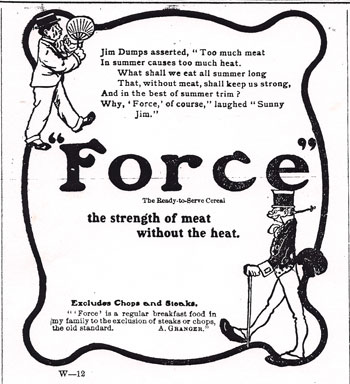
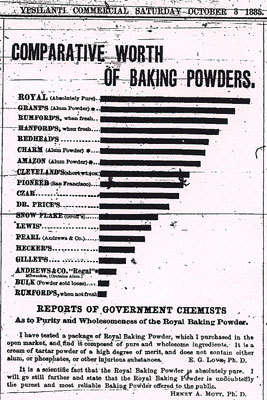


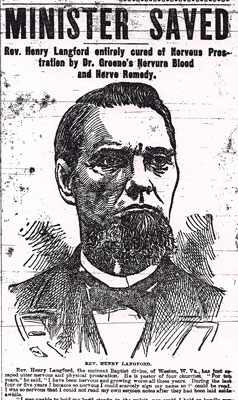
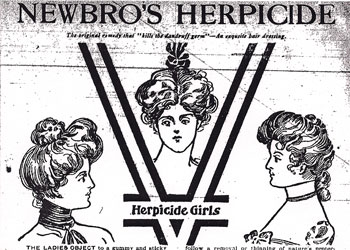
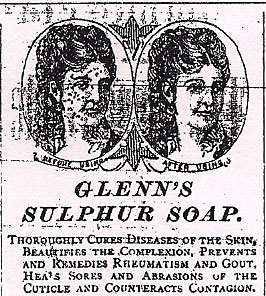
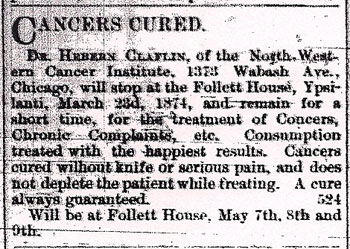


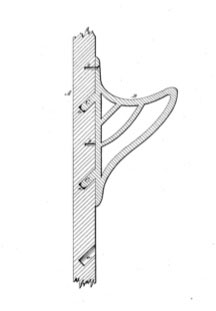
It looks like the curvy piece on the right can be placed at several levels of height on the vertical beam on the left. I’ll be a bit silly and suggest that it is a design for adjustable-height stilts.
Interesting guess cmadler, (there are no silly guesses) and thank you for reading!
cmadler, it looks like we may be teaming up again; however this time I am not as sure about myself. The vertical element on the left is representational of a wall or a vertical piece of wood, and I would say that it is not a part of the mystery item. The mystery item is then what appears to be a curving and, yes, adjustable item, like adjustable shelf pins in cabinets. But the item is larger that that. My guess is that it is an adjustable bracket for displaying clothes in a clothing store.
Was it a way to measure someone? I can’t tell how far apart the notches are.
I love those ads! It’s good to know there is a cure in case my womb ever falls.
abc: I like that guess, very inventive! But as it so happens, the wooden part on the left is part of the item.
Patti: Another good guess; that makes sense. The wooden part at left is a pole.
I believe, but could be wrong, that “fallen womb” refers to uterine prolapse. not a health expert but possibly the average hard-working rural Michigan farm wife was more prone to the condition for many of the same reasons as in this article: [link]
Do I get to keep trying? Now I am thinking scaffolding… or roof jacks. I won’t guess again though.
Of course! :) That totally looks like scaffolding, doesn’t it? The adjustable part makes sense too, so you can adjust your height as you’re painting, &c.
That pinkum nostrum’s a bummer man, anything that helps has gotta make for a good advert.
Anyone who remembers the Irish Rovers remembers their version of The Ballad of Lydia Pinkham.
“there are no silly guesses” – that sounds like a challenge! :-)
Pete: Amazingly, Lydia Pinkham’s Herbal Compound is still for sale today: [link] I am tempted to cynically interpret the two five-star reviews as evidence of the placebo effect.
Tom Brandt: That is fascinating. I had had no idea that that song was still remembered. And voila, here is a performance of “Lily the Pink,” which Wikipedia says is a modification of “The Ballad of Lydia Pinkham,” by the Irish Rovers on Youtube: [link]
“The Ballad of Lydia Pinkham” lyrics: [link]
“Lily the Pink” lyrics: [link]
cmadler: Hmm, could be. :)
From one Amazon review of the 16 oz. size of the compound: “It tastes like compost tea mixed with alcohol, in a fruity kind of way…but if you down it in a shot glass and drink water for a chaser, it’s not that horrible.” Sounds delightful.
Members of the University of Michigan Sailing Club were singing the praises of Lydia Pinkham, (for its a boon to the human race) in 1951-53. We found other things to drink but never any real Lydia Pinkham. I recall a few of the mildly scandalous verses but cannot divulge them here.
Laura – would you recommend Morrison’s book to your readers, or should we wait for the film adaptation?
Is your artifact a bracket for hanging & adjusting pocket doors?
Murph: I am not someone to listen to for book recommendations as I recently cheerfully polished off 500 pages’ worth of “History of Protestantism in Michigan, Being a Special History of the Methodist Episcopal Church and Incidentally of Other Denominations” for an Ann Arbor Observer story. I also love poring through old Michigan Board of Health reports and industrial inspection reports, &c. I did start reading the baking powder war magnum opus before deadlines forced me to snap out of it. Yet I hear its siren call….rising….